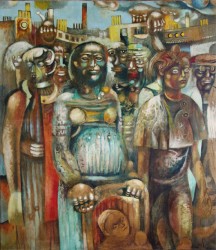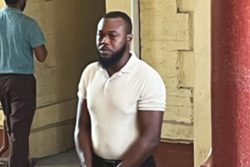Starting with Human World by Denis Williams, eminent Guyanese artist Stanley Greaves A A and artist Akima McPherson will discuss significant works of art in the Guyana National Collection, housed in the National Gallery of Art, Castellani House, Georgetown. These Conversations will be published on the first Sunday of every month. At the same time, the National Gallery of Art will make the artwork available for viewing. Human World will be on display from Tuesday, April 7 to Monday, April 13 in the ground floor gallery of Castellani House.
Akima McPherson: Could you offer a bit of background about Human World?

Photo courtesy of the National Gallery of Art, Castellani House
Stanley Greaves: Human World is a painting by Denis Williams. It appeared on Time magazine cover in 1950. A group of Guianese professionals, which included Dr Frank Williams and David Forde brought it to British Guiana. It was the first work acquired for the National Collection in 1956.
AM: Why did this particular painting by Williams make it on the Time cover? What was Denis Williams saying that distinguished it?
SG: In the 1950s, people from the Caribbean were arriving in London in numbers and were making an impression on the community.
For the first time, many Caribbeans could be seen walking the streets of London far from their homeland territory. In the painting they are living in an industrial city, judging by the chimneys in the background. To what extent are they fitting in? On the left there’s an individual who appears to be some sort of Obeah man, spiritual-worker type of person. All are now obviously part of the society. The woman to the front is pregnant and she has a baby in the pram, so she is adding to the new British-born Caribbean people. The painting is making a social statement relevant to the time.
AM: When I first saw Human World years ago, I didn’t see it as the West Indian immigrant story. I saw it as a statement about industrialisation and its control over people’s lives, and the impersonality of the city – people becoming part of the machinery of industry and of the architecture, becoming anonymous despite the crowded nature of the city.
SG: It is all of that as well. It is about people of the Caribbean who are not of that society who will now have to face the complexities that arise from living in that industrial society. These are not the faces of European British types. These are coloured people. Some of those faces resemble masks, a hint of African origins. Here is the meeting, melding of different cultures – the one being subsumed into the wider complex industrial society. The problem is how will they fit in? I think Williams is drawing on that as a theme.
AM: When you consider that a lot of work by Guianese artists were, as you had characterized them, “genre paintings” concerned with recording everyday life, what is the significant departure in Human World?
SG: Williams seems more concerned about groups of people and psychological types. I explored groups in the People of the Pavement series but no one has consistently followed up on what Williams was concerned about.
AM: What was the reaction here when Human World appeared on the cover of Time?
SG: It was big news. First it was a Guyanese, and secondly someone from the Caribbean. This has not happened for a Guyanese or Caribbean artist since then.
AM: What was the reaction to the work when it was brought home?
SG: I recall being with E R Burrowes and Donald Locke when the crate was opened.
We were all impressed by the sheer size of it. Until then we had not seen a painting this size. Most local artists did ‘cabinet paintings’ not larger than about 24”x 30” (60 x 76cm). We were also impressed by the expressionistic loose handling of the paint. At that time, few of us were experimenting with the Modernist School: Cubism, Expressionism and Surrealism.









